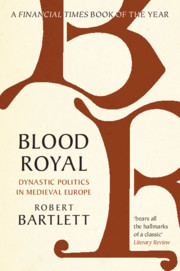Book contents
- Blood Royal
- The James Lydon Lectures in Medieval History and Culture
- Blood Royal
- Copyright page
- Dedication
- Contents
- Figures
- Preface and Acknowledgements
- Abbreviations
- Introduction Royal Families
- Part I The Life Cycle
- Part II A Sense of Dynasty
- Chapter 8 Names and Numbering
- Chapter 9 Saints, Images, Heraldry, Family Trees
- Chapter 10 Responses to Dynastic Uncertainty: Prophecy and Astrology
- Chapter 11 Pretenders and Returners: Dynastic Imposters in the Middle Ages
- Chapter 12 New Families and New Kingdoms
- Chapter 13 Dynasties and the Non-Dynastic World
- Conclusion
- Book part
- Notes
- Bibliography of Works Cited
- Index
Chapter 8 - Names and Numbering
from Part II - A Sense of Dynasty
Published online by Cambridge University Press: 09 July 2020
- Blood Royal
- The James Lydon Lectures in Medieval History and Culture
- Blood Royal
- Copyright page
- Dedication
- Contents
- Figures
- Preface and Acknowledgements
- Abbreviations
- Introduction Royal Families
- Part I The Life Cycle
- Part II A Sense of Dynasty
- Chapter 8 Names and Numbering
- Chapter 9 Saints, Images, Heraldry, Family Trees
- Chapter 10 Responses to Dynastic Uncertainty: Prophecy and Astrology
- Chapter 11 Pretenders and Returners: Dynastic Imposters in the Middle Ages
- Chapter 12 New Families and New Kingdoms
- Chapter 13 Dynasties and the Non-Dynastic World
- Conclusion
- Book part
- Notes
- Bibliography of Works Cited
- Index
Summary
This chapter deals with the ways dynastic consciousness was expressed in naming and numbering practices. It was very unusual for a medieval dynasty to have a name. Dynastic labels such as Plantagenet and Capetian are modern constructions. Ruling dynasties with hereditary surnames are exceptional, the main cases being in Ireland and Byzantium after the eleventh century. However, dynastic identity was expressed in the choice of personal names, some of which were so characteristic of a family that it is often assumed that anyone bearing them is likely to be a member. The term “Carolingian”, derived from the recurrent dynastic name “Charles” is analysed as an example. New names were introduced into dynasties through marriage and through free choice of names for younger sons. Examples of a conscious change of name usually have political significance. Numbering of monarchs began with the papacy and spread slowly and unevenly. The systems of numbering always imply a starting point and a claim to continuity. Examples analysed in detail here include the Holy Roman Emperors, the post-Conquest kings of England and the kings of Leon-Castile. The conclusion is that “a number for a monarch is far from a neutral tool of chronology”.
- Type
- Chapter
- Information
- Blood RoyalDynastic Politics in Medieval Europe, pp. 283 - 310Publisher: Cambridge University PressPrint publication year: 2020

